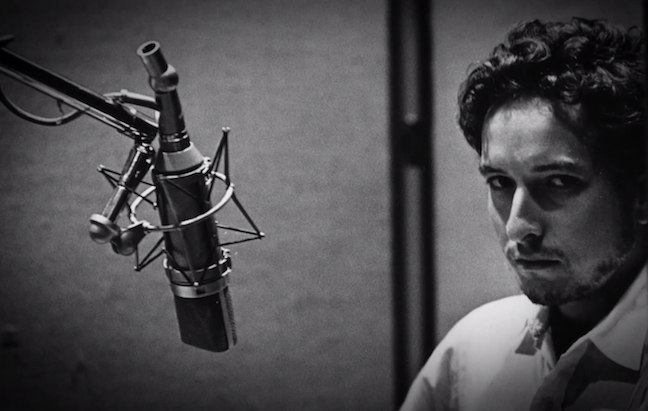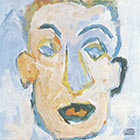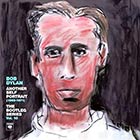Bob Dylan once dismissed his 1970 album Self Portrait as a joke. But newly released recordings from that era suggest that something serious was going on in the singer's mind
23 August 2013

Photograph by Al Clayton © Sony Music
"I don't know if I should keep playing this. Nobody's calling in and saying they want to hear it or anything … usually when something like this happens people say, 'Hey, the new Dylan album,' but not tonight." The words are those of an unspecified radio DJ, quoted in a 1970 Rolling Stone review of the album Self Portrait, a collection of 24 pieces of music that completely confounded its audience. The writer was Greil Marcus, who would go on to write some of the best commentary and criticism about Bob Dylan and his art, and whose opening sentence on this occasion eventually made his piece the most famous record review ever written: "What is this shit?"
All musical oeuvres contain duds. Plenty of musicians fall into phases where such things are all they can produce. This was Dylan's fate for much of the 1980s, as owners of such albums as Empire Burlesque and Down in the Groove will know. Self Portrait, though, is rather different: this was a deliberately bad record, apparently created to distance its creator from his public, and earn him some peace and quiet. "The reason that album was put out [was] so people would just at that time stop buying my records, and they did," Dylan later reflected. That explanation came in 1981; three years later, he described Self Portrait as "a joke".
It reached number one in the UK charts, and number four in America. Even now, millions own it – a strange package, fronted by a faux-naif Dylan painting, in keeping with its title. It comprises covers of songs made famous by the Everly Brothers, Simon and Garfunkel, the singer-songwriter Gordon Lightfoot, and more. Plenty of the tracks are smothered in syrupy arrangements, dubbed on to Nashville sessions at which Dylan was not even present. In three songs taken from his 1969 performance at the Isle of Wight festival with The Band, he sounds tired and detached: even the version of that biting countercultural anthem "Like a Rolling Stone" suggests something played by a half-cut cabaret performer.
The whole thing is stretched over 73 minutes, and the idea that it amounts to some kind of neo-Dadaist prank is there in its opening track. The music could soundtrack the opening titles of a spaghetti western, and a chorus of backing singers intones the same couplet 15 times: "All the tired horses in the sun / How'm I s'posed to get any riding done?" The approved version of the lyrics says "riding"; at times, though, it sounds distinctly like "writing".
In the first volume of Chronicles, the memoir he published in 2004, Dylan explained the genesis of Self Portrait thus: "I just threw everything I could think of at the wall, and whatever stuck, released it." He also put it firmly in the context of a time when he was a new father, trying desperately to keep his life simple, while running away from the droves of young Americans who still thought he was their king, and a purveyor of "message songs".
Having recovered from the motorcycle accident he suffered in June 1966, Dylan had remained in the upstate New York settlement of Woodstock, where he was quickly joined by the musical soulmates who would soon call themselves The Band. To his horror, though, Woodstock also became a magnet for exactly the kind of people he was trying to avoid. Attempting to shake himself free, he wrote, he did "unexpected things like pouring a bottle of whiskey over my head and walking into a department store and act[ing] pie-eyed, knowing that everyone would be talking amongst themselves as I left". His image, he resolved, "would have to be something a bit more confusing, a bit more humdrum". Unintentionally, that serves as a pretty good description of Self Portrait, a record both far too ordinary and completely perplexing.
 Self Portrait, the 1990 album
Self Portrait, the 1990 album
And then, 43 years after it was recorded, there came some unexpected news. In July this year, Dylan's record company announced the 10th instalment of the so-called Bootleg Series, whose sporadic collections of unreleased archive material began in 1991. From those who follow Dylan closely, there were gasps of surprise at what was about to be released: an anthology, available in both standard and "deluxe" versions, titled Another Self Portrait. A four-minute YouTube film told the essential story: in 2012, a tape had been found containing material from the sessions that produced the original album, which had sparked the idea of returning to this period anew. On the face of it, this rediscovered music told the story of a project that Self Portrait travestied – whose working title, according to one of the musicians involved, might have been Folk Songs of America, pointing to two later albums on which Dylan re-explored the folk repertoire, Good as I Been to You (1992) and World Gone Wrong (1993).
Was this, perhaps, further proof of the modern music industry's tendency to wring even its most lifeless assets dry? The opening sentence of the Marcus review still hangs heavy, and the fact that Self Portrait has long been understood as an act of self-sabotage suggested an obvious update: "What is this new shit?"
But Another Self Portrait is not like that at all. A lot of it is revelatory, confirming that Dylan did indeed begin the Self Portrait period with the intention of creating an anthology of songs that would simultaneously tap back into his roots in orthodox American folk music, while also pushing him somewhere new. There are songs written by the Pennsylvania-born singer-songwriter Eric Andersen and Tom Paxton and Bob Gibson, both folk singers whose age and musical style kept them clear of the counterculture that almost buried Dylan under the weight of its expectations.
Dylan returns to the old Scots ballad "The Daemon Lover" – given its American title "House Carpenter", just as it had been when he first recorded it in 1961 – and the American folk standard "Railroad Bill". As with material that eventually made it on to Self Portrait, where it was adorned with drums, bass and strings, all these songs are arranged simply: Dylan's voice and guitar, additional guitar parts by the New York multi-instrumentalist David Bromberg, and his arranger and bandleader Al Kooper on occasional piano.
But most suprising is the quality of Dylan's singing. As part of the build-up to Another Self Portrait, Sony Music put out a video to accompany a version of an 18th-century English folk song titled "Pretty Saro" – and on this recording, among others, his voice seems able to stretch single syllables into miniature melodies. Sight unseen, you would probably not think it was Dylan you were listening to. His approach develops the softened, country tones he used on Nashville Skyline, which can also be heard in exerpts from the Isle of Wight concert, spruced up and included in the "Deluxe" edition. Around eight years later, after he had reverted to the coarser vocal stylings he developed during the 1960s, Dylan's voice began to slowly fade: it is on this material, much of which has never even made it on to illegal bootlegs, that one probably hears him peak as a singer.
 Another Self Portrait
Another Self Portrait
And there is more. Amid the Self Portrait material and Isle of Wight recordings are a smattering of pieces that were recorded during sessions for the albums that book-ended Self Portrait: Nashville Skyline and New Morning.(The latter, chiefly because of the reaction to Self Portrait, was acclaimed as a stunning return to form: "his best album in years", wrote Marcus.) Two items stand out: a version of New Morning's euphoric title track, with an added part for horns written by Al Kooper, and a take of "Sign on the Window" to which Kooper added strings, harp and piccolo.
In contrast to the schmaltzy Self Portrait, no Dylan recording has ever sounded so poised, not least when the music drops and he delivers four great lines: "Build me a cabin in Utah /Marry me a wife, catch rainbow trout / Have a bunch of kids who call me pa / That must be what it's all about."
If this period of Dylan's career has one overriding meaning, these lyrics spell it out. Most of his audience surely did not want to hear such things – not when Vietnam was tearing the country apart and some people were still looking to him for a sign. Moreover, although on paper such lyrics might look so hokey as to suggest an ironic put-on, I think he meant every word: in Chronicles, after all, he writes of fantasising about "a nine-to-five existence, a house on a tree-lined block with a white picket fence, pink roses in the backyard".
In the ultimate irony, Woodstock became not just the name of his adopted hometown, but the setting for the festival that traded on his association with the place, and led him to accept the offer to play the Isle of Wight as a means of escape. Again, Chronicles captures his horror at what was afoot: "The events of the day, all the cultural mumbo jumbo, were imprisoning my soul – nauseating me – civil rights and political leaders being gunned down, the mounting of the barricades, the government crackdowns, the student radicals and demonstrators versus the cops and the unions – the streets exploding, fire of anger boiling – the contra communes – the lying, nosy voices – the free love, the anti-money system movement – the whole shebang. I was determined to put myself beyond the reach of it all. I was a family man now, didn't want to be in that group portrait."
Self-evidently, all this was profoundly political. Dylan, after all, could easily be understood as someone now following small-c conservative impulses, founded on a disdain for the tie-dyed degeneracy into which the hippies had tumbled, and a horror at how divided America had become. On Music for Big Pink, the debut album The Band released in July 1968, the four Canadians and a southerner, who dressed like gold-rush prospectors – had made the same thoughts explicit. That album began with "Tears of Rage", a song with Dylan lyrics that surveyed the USA's generational war: "What dear daughter 'neath the sun / Would treat a father so / To wait upon him hand and foot / And always tell him, No?" On the front of the record was another faux-naif Dylan painting; the gatefold featured a photograph in which the group posed with their families, parents in the foreground – a symbol, their leader Robbie Robertson later said, of "rebelling against the rebellion".
The Band had accompanied him on the homemade recordings that were eventually released as The Basement Tapes – evocations of a long-lost America, captured not just in such original pieces as "I Shall Be Released" and "This Wheel's on Fire", but scores of folk songs. In turn, that music was followed by John Wesley Harding, the pared-down Dylan album full of biblical allusions which led on to Nashville Skyline and the music Dylan recorded with Kooper and Bromberg.
Too many accounts of Dylan's progress have characterised this period as a long, fallow spell in which he lost his way: in fact, aided by some of the most capable musicians he ever worked with, fascinating recordings were pouring out of him. This was not pop music. It remains for grown-ups, full of ambiguities and sadness, and a profound sense of American history. How great to hear it at last, removed from the games its author went on to play with it: a self-portrait so improved as to make the first almost irrelevant.
• Listen to an exclusive album stream from Another Self Portrait (1969-1971): The Bootleg Series Vol 10
No comments:
Post a Comment